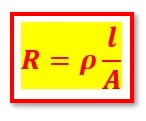What is Electrical Resistance?
The electrical resistance is described as the obstruction to the flow of electrons. Electrons are free in the conductor. When a potential or voltage source is applied across a conductor, the free electrons begin to move in the specified direction. During motion, these electrons collide with atoms and molecules of the conductor. Atoms or molecules create the impediment to the flow of electrons. This obstacle is known as resistance.
The circuit’s electrical resistance is provided by the resistor. The resistance shows the connection between the applied voltage and charge flow. Current flow is inversely proportional to the resistance.
Principle of Resistance:
The resistivity of a material:
- Depends on the type of material,
- Depending on the temperature,
- Directly related to the length of the material and
- Material’s cross-sectional area.
The principle of resistance can be stated as a result:

Where,
ρ = constant of proportionality,
l = Length and
A = Cross Sectional Area
What kind of Units are used to measure Electrical Resistance?
Ohms, the SI unit for a resistor, are used to measure the electrical resistance, and the symbol Ω is used to represent it.
Electrical Resistance Symbol:
Electrical resistance is often represented by one of two primary circuit symbols.
One of the most typical representations of a resistor, particularly in North America, is a line that is zigzagged back and forth. The alternate symbol for a resistor in a circuit is a little rectangle, which is known as the international resistor symbol because it is so commonly used in Europe and Asia.
The illustration that follows displays the symbol used in circuitry to represent resistors.
Specific resistances of the material:
The specific resistance or resistivity of a material is the resistance of the unit length and unit cross-section area of the material. It’s measured in ohmmeter.










